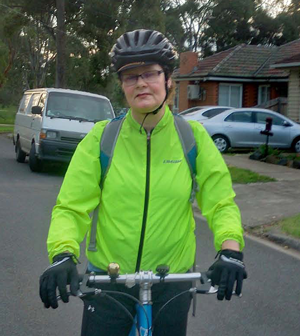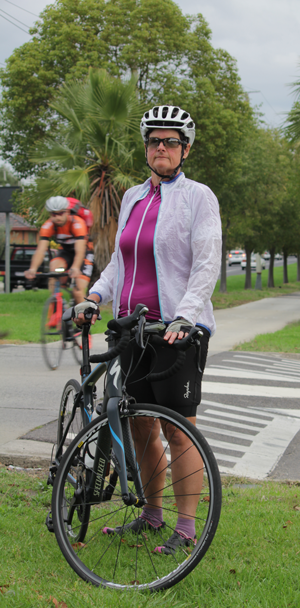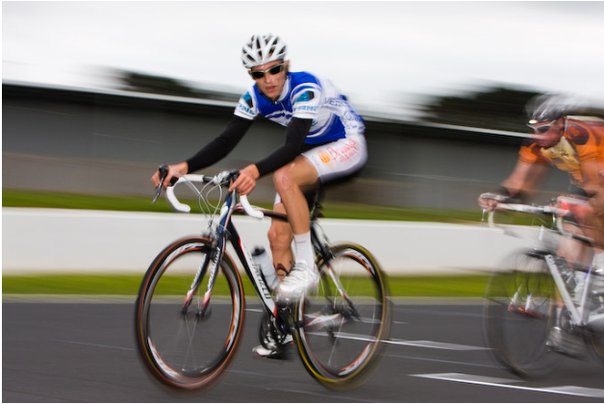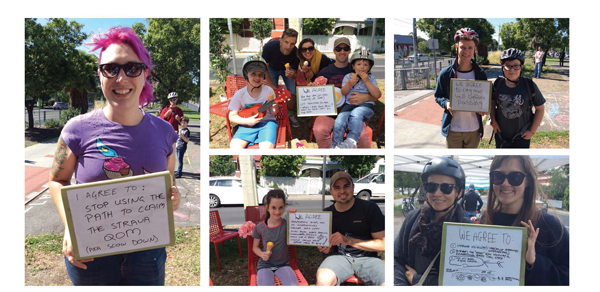Aggressive riders frighten others off the roads and paths, and some riders have had enough. Simon Vincett investigates.
Helen Smart has just about had enough. Although she’s ridden for transport for decades, she finds herself gritting her teeth for the daily commute, which she finds regularly punctuated with conflict with other riders.
After many incidents of riders overtaking too close and without warning, Helen has been recently frightened by riders undertaking fast and close as well. She wrote to Bicycle Network in frustration, after venting on online forums as well about the issue.
S he told Bicycle Network that she’s just about ready to quit riding to work because the stress of riding is becoming too much.
he told Bicycle Network that she’s just about ready to quit riding to work because the stress of riding is becoming too much.
“Then there are riders that overtake at the same time as I am overtaking a pedestrian. I have checked and thought ‘They wouldn’t do that’ and then they did,” says Helen.
Helen describes her riding as “a good commuting speed”.
“I’m not fast like the fast riders but not a slow wobbler. I’m also very defensive. I find I slow down a lot for intersections of driveways or side roads or crossings that have poor visibility whereas a lot of riders will just sail straight over. So I do tend to be a bit slower than other people but I don’t actually ride slowly.”
Helen welcomed the development of separated bike lanes on her commute but they haven’t solved her problems with other riders.
“You see the bike path and you think ‘All my problems are solved’ but you get on the bike path and you find ‘No there’s danger here too’,” she explains.
“It’s really terrifying when some heavy, muscular, fast guy is whooshing past you. If somebody just touched me in the wrong way, my bike would hit the kerb and I would lose all my teeth or break my neck – I’ve got a great imagination. I think you could really hurt yourself in those separated lanes if someone cannoned into you.”
Still, Helen believes the design of the built environment has a lot to offer. “Engineering will have a lot to do with it. Ideally I’d like car dependence to reduce quite a lot so that we can free up more space for bike lanes. Then we’d have not so narrow bikes lanes so that faster riders can overtake in safety.
“And a bit of a culture change as well so that they say ‘OK it’s not just about my Strava KOM thing, these are actually people commuting to work so I really have to be careful and not terrify people too much.’”
Because collisions can happen, as Deirdre O’Sullivan’s incident proves.
 “I was coming back from a lovely week of cycle touring with friends in Tasmania,” Deirdre recounts. “I got off the Spirit of Tasmania at about 7am on a Thursday morning. It was such a beautiful morning I decided to ride home. But of course I’d forgotten that it was commute hour. So I was going against the commute up St Georges Road [shared path in Melbourne].
“I was coming back from a lovely week of cycle touring with friends in Tasmania,” Deirdre recounts. “I got off the Spirit of Tasmania at about 7am on a Thursday morning. It was such a beautiful morning I decided to ride home. But of course I’d forgotten that it was commute hour. So I was going against the commute up St Georges Road [shared path in Melbourne].
“As I was crossing Sumner Street there was a long stream of commuters – about five or six at least – coming towards me. One of them pulled out into my lane to overtake the stream of cyclists.”
It was a moment of inattention with serious consequences, and it wasn’t Deirdre doing anything wrong.
“I was running a flashing front light, I was wearing a light blue jacket. There’s seeing and there’s seeing, you know.”
“I had no time to take evasive action and there was no room to do it in. He hit my right shoulder and hand and caused me to hit a car that was waiting to cross.
“It was very frightening and very painful. I threw the world’s biggest tantrum in the first five minutes. I was frightened. I thought my collarbone was broken. I thought my bike was broken.
“I was hurt and on the ground. The gentleman who hit me was also hurt but he was up and about. At least one other cyclist came down as well – he was able to walk away.”
Instead of arriving home, Deirdre was now plunged into dealing with the consequences of the collision, a process of many weeks.
“I had the ambulance called. They checked me out and cleared me to go home. A friend came and got me. The ambulance said to go to my GP the next day so I did that and got x-rays of my hand and shoulder.
“I had a few really, really rough days at home. There were no breaks but I’ve had to do a lot of work to get back to living. I’m not working right now but I would have had probably at least a week off work.”
It’s taken a while for Deirdre to get back on the bike.
“Day to day activities have been difficult, especially getting dressed, brushing my teeth. I’ve had to miss quite a few things that I would have otherwise participated in. Because cycling is so much of my social life it was a bit rough for a couple of weeks to limit my social opportunities.”
There’s not a lot of room on most of our bike paths and lanes – certainly no emergency stopping lane for pulling over or for evasive action. When things go wrong, they can go painfully wrong.
Deirdre feels people aren’t riding appropriately for the conditions. “People are on a mission, they’re in a hurry. The infrastructure is not perfect – not that I’m an expert. But St Georges Road Path worries me now because it’s a bit of a racetrack. I get worried about people talking about getting a good workout – it’s not the place. If you want to do that you go to the velodrome or the Boulie [Kew Boulevard] or something like that.”
A speedy rider who has learned to moderate his ways is Vaughn Allen. As a former racing cyclist, his natural style is to go hard but after a stint studying Urban Planning in the Netherlands he has seen an alternative.
 “I specifically went over there to understand how the Netherlands has become the best cycling country in the world,” Vaughn explains.
“I specifically went over there to understand how the Netherlands has become the best cycling country in the world,” Vaughn explains.
“Separated infrastructure will entice a lot more people of all walks of life to take the plunge and take up bike riding,” he declares. “Also creating lower speed environments.
“In the Netherlands there are lower speed limits. The maximum speed is 30km/h when bikes are mixed with cars. That just brings everything down to a people level. It feels much more interactive instead of hostile. In a situation where the cars and bikes mix, the bike always gets preference, so the car has to wait behind. I think that helps because whether it’s an elderly person or child, it reinforces their right to be there.”
In terms of interactions between riders and other riders, Vaughn observed a more relaxed environment.
“It was a very different riding experience to what I’m used to in Melbourne. Riding in the Netherlands is very relaxed. I think they have the slowest average cycling speeds in the world, which you wouldn’t expect for the flattest country in the world but it seems to be a lot more sociable, a lot more friendly. It has a much more diverse mix of population as well and everyone just seems to take a lot more care with looking out for one another on the bike. There’s no such thing really as a cyclist over there, because everybody is a cyclist – they’re people who choose to ride bikes.”
So how do we achieve this is Australia? This challenge has recently exercised Bicycle Network and Hobart City Council.
It is legal to ride on footpaths in Tasmania, unless they are signed otherwise. With the missing links between defined cycle routes in Hobart, and the one-way street system, riders frequently take to the footpath to take the shortest route to their destination.
“Bicycle Network in Hobart is fielding an increasing number of calls from bike riders and walkers about the behaviour of both on shared pathways,” Garry Bailey, Bicycle Network’s Tasmanian advisor, explains.
“The chief complaints from walkers are riders going too fast, not ringing their bell on approach, and passing too close to walkers. The chief complaint from riders is walkers not keeping left, walking in groups across the path, dog walkers not controlling their pooches, and people using headphones, so they can’t hear the bell.”
Urging infrastructure improvement is a constant concern for Bicycle Network but ultimately riders must be tolerant and share the space we have.
“Last year Bicycle Network, in partnership with the council, handed out small path-etiquette guides. We have also had a media presence on this issue to help get the message out.”
Also recently addressing etiquette for bike riders was an attractive campaign by Sydney Cycleways: the Art of Gracious Cycling. Asking “Are you a gracious rider?” the video models friendly, tolerant riding behaviour.
Similarly the City of Darebin, the Melbourne municipality in whose boundaries lies the St Georges Road Path on which Deirdre came a cropper, staged a major intervention on the path to encourage people to share. After accepting a free ice-cream, riders pledged how they would better share the path.
Because paths are more than commuting arterials. We want our paths to be suitable for children to ride, for the elderly and people with a disability, illness and infirmity to be as active as they can be, as well as valuable spaces for pushing the pram and walking the dog or just going for a jog. Moreover, new riders won’t take up the ‘riding as a transport’ option while it appears you have to be fast and tough to survive in the bike commuting environment.
Even though she was the victim of a collision herself, Deirdre, identified a surprising insight: “It actually made me think that I’ve ridden too close to people on paths and not realised how it makes you feel. You never know if people are hurt or unsteady.
“You know it’s not a race – share the path, slow down and don’t overtake people unless it’s absolutely clear.”
Main image courtesy of The Change Collective
Ride On content is editorially independent, but is supported financially by members of Bicycle Network. If you enjoy our articles and want to support the future publication of high-quality content, please consider helping out by becoming a member.


Isn’t the st george’s rd path about to go through a redesign?
My observation is that both ladies don’t seem to have a mirror on their bikes,I find they give early warning well before a bike or vehicle comes up behind you. You can’t rely on sound only when the vehicle is going to run over your back.Mirrors unfortunately don’t look KooL or dare I say it Gay but to me a must have. Safe Cycling GuyZ.
Why do people keep linked riding fast with Strava and KOMs!! If you have a 30-40km commute each way you aren’t going to want to travel slowly or you’ll spend more time commuting than actually working! It’s like saying Mamals! It’s insulting and generalistic. I wear Lycra so I do t chaff and I ride as fast as I can on commutes for many reasons… The least bring strava or KOMs!
But the issue of thin bike paths is an issue. It’s why I ride on the road. All the traffic. Is going one way and I’m not trying to avoid wobbly slow commuters on flat long bar bikes.
Again… Keep strava out of arguments and legitimate cycling stories and I might respect more what you say rather than your rude assumptions.